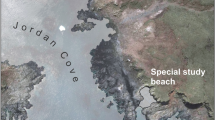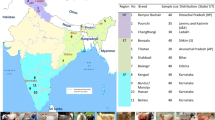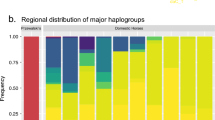Abstract
The Icelandic horse has been maintained as a closed population in its eponymous homeland for many generations, with no recorded introductions of new horses of any breed since the year 1000 CE. Here we determined the diversity of major histocompatibility complex (MHC) haplotypes in 156 Icelandic horses from two groups, based on a panel of 12 polymorphic intra-MHC microsatellites tested in families of various composition. We identified a total of 79 MHC haplotypes in these two groups, including one documented intra-MHC recombination event from a total of 147 observed meioses. None of these MHC haplotypes have been previously described in any other horse breed. Only one MHC homozygote was found in the entire population studied. These results indicate a very high level of MHC heterozygosity and haplotype diversity in the Icelandic horse. The environment in Iceland is remarkable for its lack of common agents of equine infectious disease, including equine herpesvirus type 1, influenza virus, and streptococcus equi. The driving forces for maintenance of MHC heterozygosity in Icelandic horses must thus be sought outside of these major horse pathogens. Based on our results, we propose that intra-MHC recombination may play a major role in the generation of novel haplotypes.
This is a preview of subscription content, access via your institution
Access options
Subscribe to this journal
Receive 6 digital issues and online access to articles
$119.00 per year
only $19.83 per issue
Buy this article
- Purchase on Springer Link
- Instant access to full article PDF
Prices may be subject to local taxes which are calculated during checkout



Similar content being viewed by others
References
Hreiðarsdóttir GEÁ, Svansson T, Hallsson V. Analysis of the history and population structure of the Icelandic horse using pedigree data and DNA analyses. ICEL Agric Sci. 2014;27:63–79.
Bjornstad G, Nilsen NO, Roed KH. Genetic relationship between Mongolian and Norwegian horses? Anim Genet. 2003;34:55–8.
Frankham R. Do island populations have less genetic variation than mainland populations? Heredity. 1997;78:311–27.
Meiri S, Cooper N, Purvis A. The island rule: made to be broken? Proc Biol Sci. 2008;275:141–8.
Hugason K. Breeding of Icelandic Toelter horses—an overview. Livest Prod Sci. 1994;40:21–9.
Adalsteinsson S. Inheritance of the palomino color in Icelandic horses. J Hered. 1974;65:15–20.
Kristjansson T, Bjornsdottir S, Sigurdsson A, Andersson LS, Lindgren G, Helyar SJ, et al. The effect of the ‘Gait keeper’ mutation in the DMRT3 gene on gaiting ability in Icelandic horses. J Anim Breed Genet. 2014;131:415–25.
Jaderkvist Fegraeus K, Hirschberg I, Arnason T, Andersson L, Velie BD, Andersson LS, et al. To pace or not to pace: a pilot study of four- and five-gaited Icelandic horses homozygous for the DMRT3 ‘Gait Keeper’ mutation. Anim Genet. 2017;48:694–7.
Wutke S, Andersson L, Benecke N, Sandoval-Castellanos E, Gonzalez J, Hallsson JH, et al. The origin of ambling horses. Curr Biol. 2016;26:R697–R9.
Hendricks BL. International encyclopedia of horse breeds. 1st ed. Norman: University of Oklahoma Press; 1995.
Campana MG, Stock F, Barrett E, Benecke N, Barker GW, Seetah K, et al. Genetic stability in the Icelandic horse breed. Anim Genet. 2012;43:447–9.
Glowatzki-Mullis ML, Muntwyler J, Pfister W, Marti E, Rieder S, Poncet PA, et al. Genetic diversity among horse populations with a special focus on the Franches-Montagnes breed. Anim Genet. 2006;37:33–9.
Thorsteinsdottir L, Torfason EG, Torsteinsdottir S, Svansson V. Isolation and partial sequencing of Equid herpesvirus 5 from a horse in Iceland. J Vet Diagn Investig. 2010;22:420–3.
Bjornsdottir S, Harris SR, Svansson V, Gunnarsson E, Sigurethardottir OG, Gammeljord K, et al. Genomic dissection of an Icelandic epidemic of respiratory disease in horses and associated zoonotic cases. mBio. 2017;8:e00826–17.
Eriksson S, Grandinson K, Fikse WF, Lindberg L, Mikko S, Brostrom H, et al. Genetic analysis of insect bite hypersensitivity (summer eczema) in Icelandic horses. Animal. 2008;2:360–5.
Schaffartzik A, Hamza E, Janda J, Crameri R, Marti E, Rhyner C. Equine insect bite hypersensitivity: what do we know? Vet Immunol Immunopathol. 2012;147:113–26.
Klumplerova M, Vychodilova L, Bobrova O, Cvanova M, Futas J, Janova E, et al. Major histocompatibility complex and other allergy-related candidate genes associated with insect bite hypersensitivity in Icelandic horses. Mol Biol Rep. 2013;40:3333–40.
Andersson LS, Swinburne JE, Meadows JR, Brostrom H, Eriksson S, Fikse WF, et al. The same ELA class II risk factors confer equine insect bite hypersensitivity in two distinct populations. Immunogenetics. 2012;64:201–8.
Halldorsdottir S, Lazary S, Gunnarsson E, Larsen HJ. Distribution of leucocyte antigens in Icelandic horses affected with summer eczema compared to non-affected horses. Equine Vet J. 1991;23:300–2.
Marti E, Gerber H, Lazary S. On the genetic basis of equine allergic diseases: II. Insect bite dermal hypersensitivity. Equine Vet J. 1992;24:113–7.
Lazary S, Marti E, Szalai G, Gaillard C, Gerber H. Studies on the frequency and associations of equine leucocyte antigens in sarcoid and summer dermatitis. Anim Genet. 1994;25:75–80.
Shrestha M, Eriksson S, Schurink A, Andersson LS, Sundquist M, Frey R, et al. Genome-Wide Association Study of insect bite hypersensitivity in Swedish-born Icelandic horses. J Hered. 2015;106:366–74.
Kelley J, Walter L, Trowsdale J. Comparative genomics of major histocompatibility complexes. Immunogenetics. 2005;56:683–95.
Antoniou AN, Powis SJ. Pathogen evasion strategies for the major histocompatibility complex class I assembly pathway. Immunology. 2008;124:1–12.
Sin YW, Annavi G, Dugdale HL, Newman C, Burke T, MacDonald DW. Pathogen burden, co-infection and major histocompatibility complex variability in the European badger (Meles meles). Mol Ecol. 2014;23:5072–88.
Trowsdale J. The MHC, disease and selection. Immunol Lett. 2011;137:1–8.
Kamiya T, O’Dwyer K, Westerdahl H, Senior A, Nakagawa S. A quantitative review of MHC-based mating preference: the role of diversity and dissimilarity. Mol Ecol. 2014;23:5151–63.
Wade CM, Giulotto E, Sigurdsson S, Zoli M, Gnerre S, Imsland F, et al. Genome sequence, comparative analysis, and population genetics of the domestic horse. Science. 2009;326:865–7.
Gustafson AL, Tallmadge RL, Ramlachan N, Miller D, Bird H, Antczak DF, et al. An ordered BAC contig map of the equine major histocompatibility complex. Cytogenet Genome Res. 2003;102:189–95.
Tallmadge RL, Lear TL, Antczak DF. Genomic characterization of MHC class I genes of the horse. Immunogenetics. 2005;57:763–74.
Tallmadge RL, Campbell JA, Miller DC, Antczak DF. Analysis of MHC class I genes across horse MHC haplotypes. Immunogenetics. 2010;62:159–72.
Miller D, Tallmadge RL, Binns M, Zhu B, Mohamoud YA, Ahmed A, et al. Polymorphism at expressed DQ and DR loci in five common equine MHC haplotypes. Immunogenetics. 2017;69:145–56.
Lazary S, Antczak DF, Bailey E, Bell TK, Bernoco D, Byrns G, et al. Joint Report of the Fifth International Workshop on lymphocyte alloantigens of the horse, Baton Rouge, Louisiana, 31 October–1 November 1987. Anim Genet. 1988;19:447–56.
Tseng CT, Miller D, Cassano J, Bailey E, Antczak DF. Identification of equine major histocompatibility complex haplotypes using polymorphic microsatellites. Anim Genet. 2010;41:150–3.
Sadeghi R, Moradi-Shahrbabak M, Miraei Ashtiani SR, Miller DC, Antczak DF. MHC haplotype diversity in Persian Arabian horses determined using polymorphic microsatellites. Immunogenetics. 2018;70:305–15.
Plante Y, Vega-Pla JL, Lucas Z, Colling D, de March B, Buchanan F. Genetic diversity in a feral horse population from Sable Island, Canada. J Hered. 2007;98:594–602.
Ovchinnikov IV, Dahms T, Herauf B, McCann B, Juras R, Castaneda C, et al. Genetic diversity and origin of the feral horses in Theodore Roosevelt National Park. PLoS ONE. 2018;13:e0200795.
Antczak DF, Bailey E, Barger B, Guerin G, Lazary S, McClure J, et al. Joint report of the Third International Workshop on lymphocyte alloantigens of the Horse, Kennett Square, Pennsylvania, 25–27 April 1984. Anim Genet. 1986;17:363–73.
Petersen JL, Mickelson JR, Cothran EG, Andersson LS, Axelsson J, Bailey E, et al. Genetic diversity in the modern horse illustrated from genome-wide SNP data. PLoS ONE. 2013;8:e54997.
Bjornstad G, Roed KH. Breed demarcation and potential for breed allocation of horses assessed by microsatellite markers. Anim Genet. 2001;32:59–65.
Brinkmeyer-Langford CL, Cai JJ, Gill CA, Skow LC. Microsatellite variation in the equine MHC. Anim Genet. 2013;44:267–75.
Carrington M. Recombination within the human MHC. Immunol Rev. 1999;167:245–56.
Pennington LR, Lunney JK, Sachs DH. Transplantation in miniature swine. VIII. Recombination within the major histocompatibility complex of miniature swine. Transplantation. 1981;31:66–71.
de Groot N, Doxiadis GG, Otting N, de Vos-Rouweler AJ, Bontrop RE. Differential recombination dynamics within the MHC of macaque species. Immunogenetics. 2014;66:535–44.
Heine D, Khambata S, Wydner KS, Passmore HC. Analysis of recombinational hot spots associated with the p haplotype of the mouse MHC. Genomics. 1994;23:168–77.
Lam TH, Shen M, Chia JM, Chan SH, Ren EC. Population-specific recombination sites within the human MHC region. Heredity. 2013;111:131–8.
Leclercq S, Rivals E, Jarne P. DNA slippage occurs at microsatellite loci without minimal threshold length in humans: a comparative genomic approach. Genome Biol Evol. 2010;2:325–35.
Doxiadis GG, de Groot N, Otting N, de Vos-Rouweler AJ, Bolijn MJ, Heijmans CM, et al. Haplotype diversity generated by ancient recombination-like events in the MHC of Indian rhesus macaques. Immunogenetics. 2013;65:569–84.
Ballingall KT, Lantier I, Todd H, Lantier F, Rocchi M. Structural and functional diversity arising from intra- and inter-haplotype combinations of duplicated DQA and B loci within the ovine MHC. Immunogenetics. 2018;70:257–69.
Gao C, Quan J, Jiang X, Li C, Lu X, Chen H. Swine leukocyte antigen diversity in Canadian specific pathogen-free yorkshire and landrace pigs. Front Immunol. 2017;8:282.
Otting N, de Groot NG, Bontrop RE. Limited MHC class II gene polymorphism in the West African chimpanzee is distributed maximally by haplotype diversity. Immunogenetics. 2019;71:13–23.
Alter I, Gragert L, Fingerson S, Maiers M, Louzoun Y. HLA class I haplotype diversity is consistent with selection for frequent existing haplotypes. PLoS Comput Biol. 2017;13:e1005693.
Codner GF, Stear MJ, Reeve R, Matthews L, Ellis SA. Selective forces shaping diversity in the class I region of the major histocompatibility complex in dairy cattle. Anim Genet. 2012;43:239–49.
Schwartz JC, Hammond JA. The assembly and characterisation of two structurally distinct cattle MHC class I haplotypes point to the mechanisms driving diversity. Immunogenetics. 2015;67:539–44.
Bailey E. Segregation distortion within the equine MHC; analogy to a mouse T/t-complex trait. Immunogenetics. 1986;24:225–9.
Sugimoto M. Developmental genetics of the mouse t-complex. Genes Genet Syst. 2014;89:109–20.
Staiger EA, Tseng CT, Miller D, Cassano JM, Nasir L, Garrick D, et al. Host genetic influence on papillomavirus-induced tumors in the horse. Int J Cancer. 2016;139:784–92.
Fritz KL, Kaese HJ, Valberg SJ, Hendrickson JA, Rendahl AK, Bellone RR, et al. Genetic risk factors for insidious equine recurrent uveitis in Appaloosa horses. Anim Genet. 2014;45:392–9.
Horecky C, Horecka E, Futas J, Janova E, Horin P, Knoll A. Microsatellite markers for evaluating the diversity of the natural killer complex and major histocompatibility complex genomic regions in domestic horses. HLA. 2018;91:271–9.
Acknowledgements
We thank Alison Keggan and Becky Harman for their expert technical assistance. This study was supported in part by a grant from the Harry M. Zweig Memorial Fund for Equine Research in New York state. DFA is an investigator of the Dorothy Russell Havemeyer Foundation, Inc.
Author information
Authors and Affiliations
Corresponding author
Ethics declarations
Conflict of interest
The authors declare that they have no conflict of interest.
Additional information
Publisher’s note: Springer Nature remains neutral with regard to jurisdictional claims in published maps and institutional affiliations.
Supplementary information
Rights and permissions
About this article
Cite this article
Holmes, C.M., Violette, N., Miller, D. et al. MHC haplotype diversity in Icelandic horses determined by polymorphic microsatellites. Genes Immun 20, 660–670 (2019). https://doi.org/10.1038/s41435-019-0075-y
Received:
Revised:
Accepted:
Published:
Issue Date:
DOI: https://doi.org/10.1038/s41435-019-0075-y
This article is cited by
-
IgE-binding monocytes upregulate the coagulation cascade in allergic horses
Genes & Immunity (2023)
-
Allo-antibody production after intraarticular administration of mesenchymal stem cells (MSCs) in an equine osteoarthritis model: effect of repeated administration, MSC inflammatory stimulation, and equine leukocyte antigen (ELA) compatibility
Stem Cell Research & Therapy (2020)



